weight CITROEN C4 2019 Owners Manual
[x] Cancel search | Manufacturer: CITROEN, Model Year: 2019, Model line: C4, Model: CITROEN C4 2019Pages: 317, PDF Size: 9.31 MB
Page 5 of 317
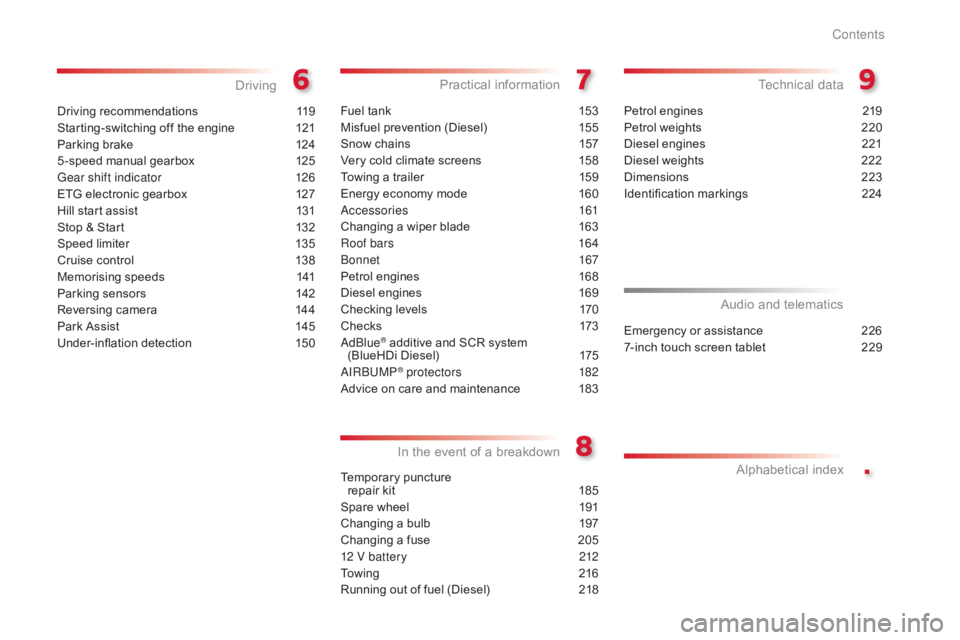
.
C4-cactus_en_Chap00a_sommaire_ed01-2016
Drivingô recommendationsô 119
Starting-switching ô off ô the ô engine ô
1
21
Parking
ô brake ô
1
24
5 -speed
ô manual ô gearbox ô
1
25
Gear shift indicator
1
26
ETG
ô electronic ô gearbox ô
1
27
Hill
ô start ô assist ô
1
31
Stop
ô & ô Start ô
1
32
Speed
ô limiter ô
1
35
Cruise
ô control ô
1
38
Memorising
ô speeds ô
1
41
Parking
ô sensors ô
1
42
Reversing
ô camera ô
1
44
Park
ô Assist ô
1
45
Under-inflation
ô d
etection
ô 1
50
Driving
Fuelô tankô 1 53
Misfuel ô prevention ô (Diesel) ô
1
55
Snow
ô chains ô
1
57
Very
ô cold ô climate ô screens ô
1
58
Towing
ô a ô trailer ô
1
59
Energy
ô economy ô mode ô
1
60
Accessories
161
Changing
ô a ô wiper ô blade ô
1
63
Roof bars
1
64
Bonnet
167
Petrol
ô engines ô
1
68
Diesel
ô engines ô
1
69
Checking
ô levels ô
1
70
Checks
ô 1
73
AdBlue
ôÛô additiveô andô SCRô systemô
(
BlueHDi ô Diesel) ô 1 75
AIRBUMP
ôÛ protectors 1 82
Advice
ô
on
ô
care ô and ô maintenance ô
1
83
Practicalô information
Temporaryô punctureô
r epair ô kit ô 1 85
Spare
ô wheel ô
1
91
Changing
ô a ô bulb ô
1
97
Changing
ô a ô fuse ô
2
05
12 V battery
2
12
To w i n g
ô 2
16
Running
ô out ô of ô fuel ô (Diesel) ô
2
18
Inô theô event ô o f ô a ô b reakdown
Petrolô enginesô 2 19
Petrol ô weights ô
2
20
Diesel
ô engines ô
2
21
Diesel
ô weights ô
2
22
Dimensions
ô 2
23
Identification
ô ma
rkings
ô 2
24
Technical data
Emergencyô orô assistanceô 226
7-inch ô touch ô screen ô tablet ô
2
29
Audioô andô telematics
Alphabetical
ô in
dex
Contents
Page 10 of 317
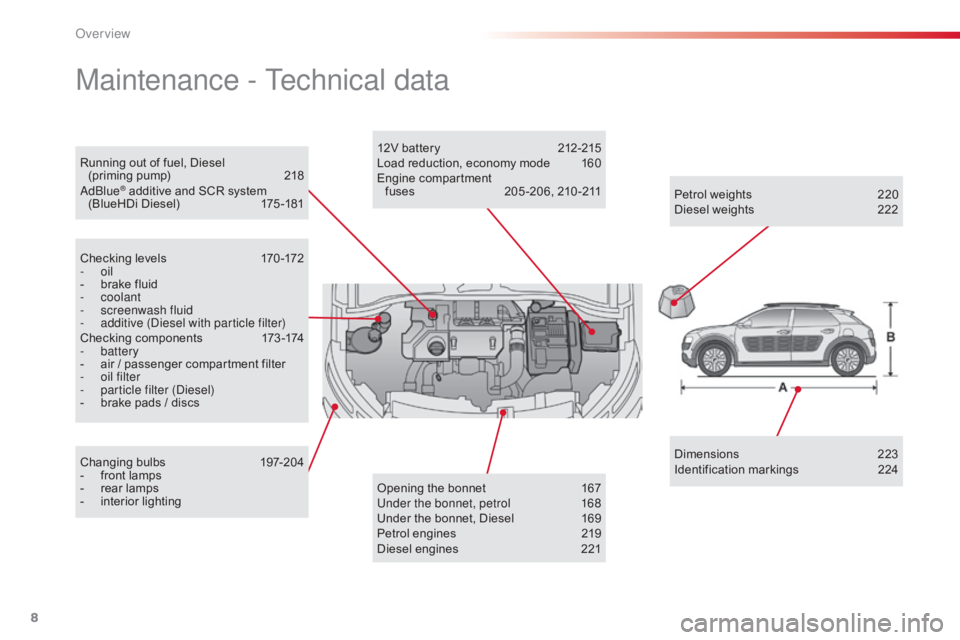
8
C4-cactus_en_Chap00b_vue-ensemble_ed01-2016
Runningô outô ofô fuel,ô Dieselô
( priming ô pump) ô 2 18
AdBlue
ôÛô additiveô andô SCRô systemô (
BlueHDi ô Diesel) ô 1 75 -181
Maintenance - Technical data
Checkingô levelsô 1 70 -172
- oil
-
ô
b
rake ô fluid
-
coolant
-
s
creenwash fluid
-
a
dditive (Diesel with particle filter)
Checking
ô components ô
1
73 -174
-
battery
-
ô
a
ir ô / ô passenger ô compartment ô filter
-
o
il filter
-
p
article filter (Diesel)
-
ô
b
rake ô pads ô / ô discs
Changing
ô bu
lbs
ô 1
97-204
-
ô
f
ront ô lamps
-
ô
r
ear ô lamps
-
ô i
nterior
ô l
ighting Dimensions
ô 2
23
Identification
ô ma
rkings
ô 2
24
Petrol
ô weights ô
2
20
Diesel ô weights ô
2
22
Opening ô the ô bonnet ô
1
67
Under the bonnet, petrol
1
68
Under
ô the ô bonnet, ô Diesel ô
1
69
Petrol
ô engines ô
2
19
Diesel
ô engines ô
2
21
12V
ô battery ô
2
12-215
Load ô reduction, ô economy ô mode ô
1
60
Engine
ô c
ompartment
ô
f
uses ô
2
05 -206, ô 210 -211
Over view
Page 106 of 317

104
C4-cactus_en_Chap05_securite_ed01-2016
Generalô pointsô relatingô toô childô seats
CITROûN recommends that children
should travel on the rear seats of your
vehicle:
-
r
earward facing
ô
up ô to ô the ô age ô of ô 3,
-
fo
rward facing
ô
over ô the ô age ô of ô 3.
Although
ô
one
ô
of
ô
CITROûN
ô
main
ô
criteria
ô
when
ô
designing
ô
your ô vehicle, ô the ô safety ô of ô your ô children ô also ô depends ô on ô you.
For
ô
maximum
ô
safety,
ô
please
ô
observe
ô
the
ô f
ollowingô r
ecommendations:
-
ô
i
n
ô
accordance
ô
with
ô
European
ô
regulations,
ô
a
ll children under the age of 12 or less
than one and a half metres tall must
travel in approved child seats suited to
their weight , on seats fitted with a seat
belt
ô
or
ô
ISOFIX
ô
mountings*,
-
s
tatistically, the safest seats in your
vehicle for carr ying children are the
rear seats,
-
a c
hild weighing less than 9 kg must
travel in the rear ward facing position
both in the front and in the rear.
*
ô ô
T
he ô regulations ô on ô carrying ô children ô are ô
s
pecific ô to ô each ô country. ô Refer ô to ô the ô
l
egislation ô in ô force ô in ô your ô country.
Safety
Page 113 of 317
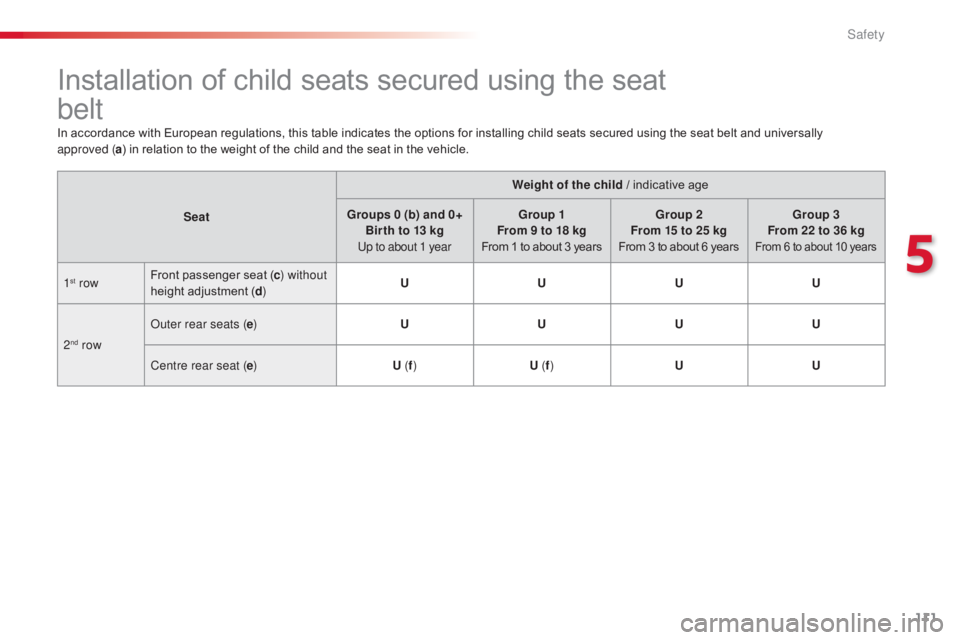
111
C4-cactus_en_Chap05_securite_ed01-2016
Installationô ofô childô seatsô securedô usingô theô seatô
bel t
Inô accordanceô withô Europeanô regulations,ô thisô tableô indicatesô theô optionsô forô installingô childô seatsô securedô usingô theô seatô beltô andô universallyô a
pproved (a )
ô in ô relation ô to ô the ô weight ô of ô the ô child ô and ô the ô seat ô in ô the ô vehicle.
Seat Weight of the child /
ô
indicative ô age
Groups 0 (b) and 0+ Bir th to 13 kg
Up to about 1 year Group 1
From 9 to 18 kg
From
ô 1 ô to ô about ô 3 ô yearsGroup 2
From 15 to 25 kg
From
ô 3 ô to ô about ô 6 ô yearsGroup 3
From 22 to 36 kg
Fromô 6ô toô aboutô 10ô years
1st row Front ô passenger ô seat ô (
c ) without
height ô adjustment ô (d ) U
UUU
2
nd row Outer rear seats (
e) UUUU
Centre rear seat ( e) U (f) U (f) U U
5
Safety
Page 117 of 317
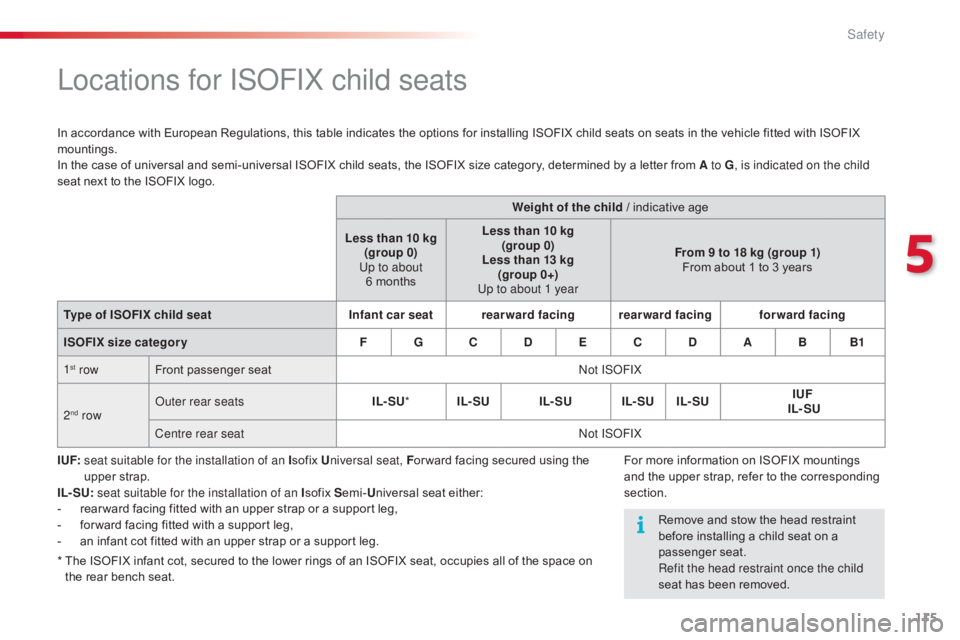
115
C4-cactus_en_Chap05_securite_ed01-2016
Locations for ISOFIX child seats
Inô accordanceô withô Europeanô Regulations,ô thisô tableô indicatesô theô optionsô forô installingô ISOFIXô childô seatsô onô seatsô inô theô vehicleô fittedô withô ISOFIXô mountings.
In
ô the ô case ô of ô universal ô and ô semi-universal ô ISOFIX ô child ô seats, ô the ô ISOFIX ô size ô category, ô determined ô by ô a ô letter ô from ô A to G, is indicated on the child
seat
ô next ô to ô the ô ISOFIX ô logo.
I UF:
s
eat suitable for the installation of an I sofix
ô Universal seat, F or ward
ô facing ô secured ô using ô the ô
u
pper ô strap.
IL- SU: seat suitable for the installation of an I sofix
ô Semi- Universal
ô sea
t
ô ei
ther:
-
ô
r
ear ward ô facing ô fitted ô with ô an ô upper ô strap ô or ô a ô support ô leg,
-
ô
f
or ward ô facing ô fitted ô with ô a ô support ô leg,
-
ô
a
n ô infant ô cot ô fitted ô with ô an ô upper ô strap ô or ô a ô support ô leg.Weight of the child
ô / ô indicative ô age
Less than 10 kg (group 0)
Up to about 6ô months Less than 10 kg
(group 0)
Less than 13 kg (group 0+)
Up to about 1 year From 9 to 18 kg (group 1)
From
ô about ô 1 ô to ô 3 ô years
Type of ISOFIX child seat Infant car seatrearward facing rearward facing forward facing
ISOFIX size categor y F G C D E C D A B B1
1
st row Frontô p assengerô sea t Not ISOFIX
2
nd row Outer rear seats
IL- SU* IL- SU IL- SU IL- SU IL- SU IUF
IL- SU
Centre rear seat Not ISOFIX
Remove
ô and ô stow ô the ô head ô restraint ô
b
efore ô installing ô a ô child ô seat ô on ô a ô
p
assenger
ô sea
t.
Refit the head restraint once the child
seat
ô has ô been ô removed.
For
ô more ô information ô on ô ISOFIX ô mountings ô
a
nd ô the ô upper ô strap, ô refer ô to ô the ô corresponding ô
s
ection.
*
ô ô
T
he ô ISOFIX ô infant ô cot, ô secured ô to ô the ô lower ô rings ô of ô an ô ISOFIX ô seat, ô occupies ô all ô of ô the ô space ô on ô
t
he ô rear ô bench ô seat.
5
Safety
Page 122 of 317
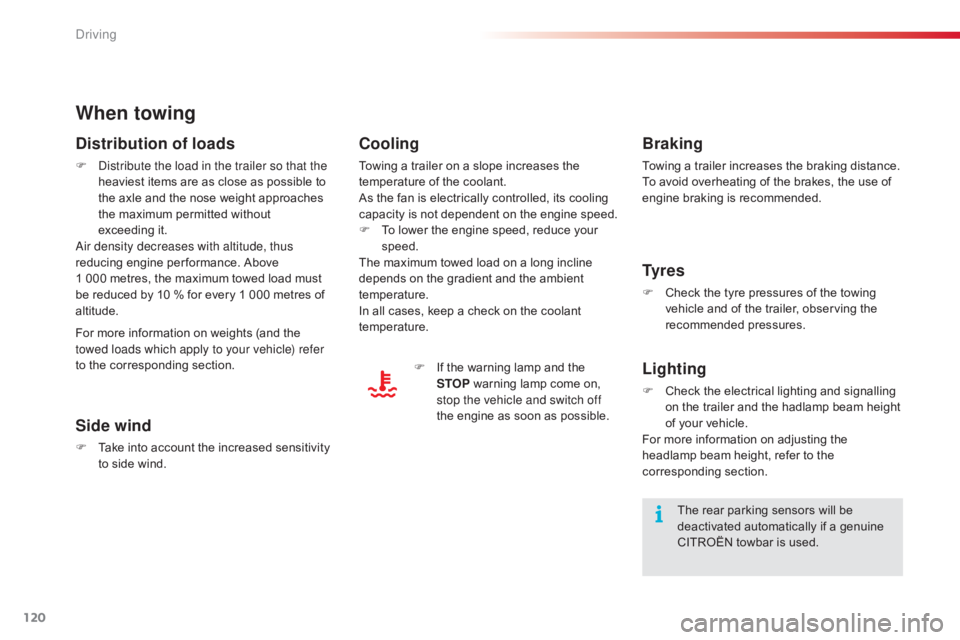
120
C4-cactus_en_Chap06_conduite_ed01-2016
When towing
Distribution of loads
F Distribute the load in the trailer so that the heaviest ô items ô are ô as ô close ô as ô possible ô to ô
t
he ô axle ô and ô the ô nose ô weight ô approaches ô
t
he ô maximum ô permitted ô without ô
e
xceedingô it.
Air density decreases with altitude, thus
reducing
ô engine ô per formance. ô Above ô
1ô 0
00ô metres, ô the ô maximum ô towed ô load ô must ô
b
e ô reduced ô by ô 10ô % ô for ô every ô 1ô 000 ô metres ô of ô
al
titude.
For
ô more ô information ô on ô weights ô (and ô the ô
t
owed loads which apply to your vehicle) refer
to
ô the ô corresponding ô section.
Side wind
Fô Takeô into ô account ô the ô increased ô sensitivity ô t
o ô side ô wind.
Cooling
Towingô aô trailerô onô aô slopeô increasesô theô temperature ô of ô the ô coolant.
As
ô the ô fan ô is ô electrically ô controlled, ô its ô cooling ô
c
apacity ô is ô not ô dependent ô on ô the ô engine ô speed.
F
ô
T
o ô lower ô the ô engine ô speed, ô reduce ô your ô
s
peed.
The
ô maximum ô towed ô load ô on ô a ô long ô incline ô
d
epends ô on ô the ô gradient ô and ô the ô ambient ô
t
emperature.
In
ô all ô cases, ô keep ô a ô check ô on ô the ô coolant ô
t
emperature. F
ô
I
f ô the ô warning ô lamp ô and ô the ô
S
TOP
ô
warning ô lamp ô come ô on, ô
s
top the vehicle and switch off
the
ô engine ô as ô soon ô as ô possible.
Braking
Towingô aô trailerô increasesô theô brakingô distance.
T o ô avoid ô overheating ô of ô the ô brakes, ô the ô use ô of ô
e
ngine ô braking ô is ô recommended.
Ty r e s
Fô Checkô the ô tyre ô pressures ô of ô the ô towing ô v
ehicle ô and ô of ô the ô trailer, ô observing ô the ô
re
commended
ô p
ressures.
Lighting
Fô Checkô the ô electrical ô lighting ô and ô signalling ô o
n ô the ô trailer ô and ô the ô hadlamp ô beam ô height ô
o
f ô your ô vehicle.
For
ô more ô information ô on ô adjusting ô the ô
h
eadlamp ô beam ô height, ô refer ô to ô the ô
c
orresponding
ô s
ection.
The
ô rear ô parking ô sensors ô will ô be ô
d
eactivated ô automatically ô if ô a ô genuine ô
C
ITROûN ô towbar ô is ô used.
Driving
Page 161 of 317
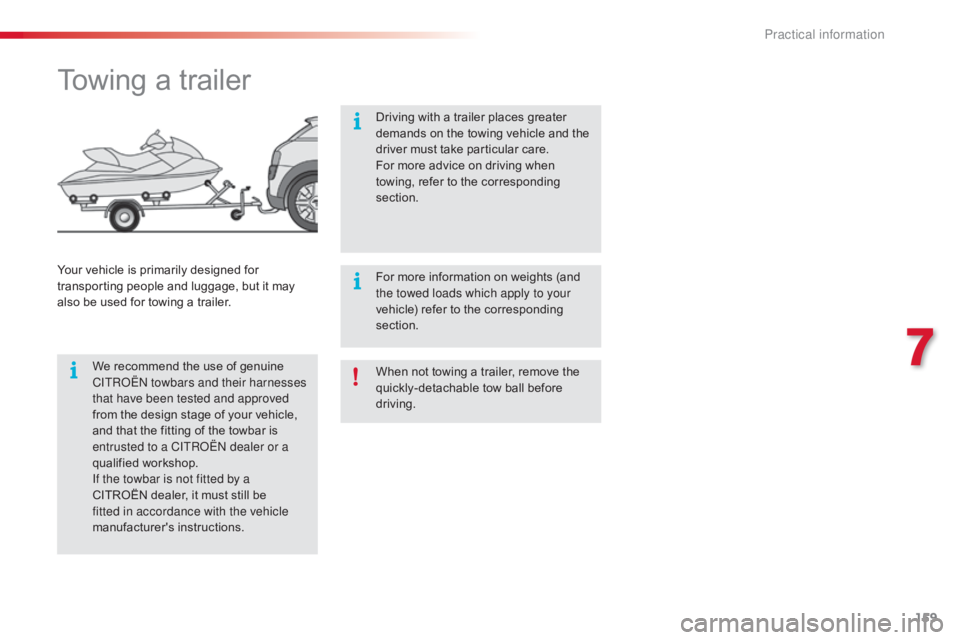
159
C4-cactus_en_Chap07_info-pratiques_ed01-2016
Whenô notô towingô aô trailer,ô removeô theô quickly-detachable ô tow ô ball ô before ô
d
riving.
Towingô aô trailer
Weô recommendô theô useô ofô genuineô C ITROûN towbars and their harnesses
that have been tested and approved
from
ô the ô design ô stage ô of ô your ô vehicle, ô
a
nd ô that ô the ô fitting ô of ô the ô towbar ô is ô
e
ntrusted to a CITROûN dealer or a
qualified
ô w
orkshop.
If the towbar is not fitted by a
CITROûN
ô dealer, ô it ô must ô still ô be ô
f
itted in accordance with the vehicle
manufacturer's
ô i
nstructions.
Your
ô
vehicle ô is ô primarily ô designed ô for ô
t
ransporting ô people ô and ô luggage, ô but ô it ô may ô
a
lso
ô
be ô used ô for ô towing ô a ô trailer. Driving ô with ô a ô trailer ô places ô greater ô
d
emands ô on ô the ô towing ô vehicle ô and ô the ô
d
river ô must ô take ô particular ô care.
For ô more ô advice ô on ô driving ô when ô
t
owing, ô refer ô to ô the ô corresponding ô
s
ection.
For ô more ô information ô on ô weights ô (and ô
t
he towed loads which apply to your
vehicle) ô refer ô to ô the ô corresponding ô
s
ection.
7
Practical information
Page 218 of 317
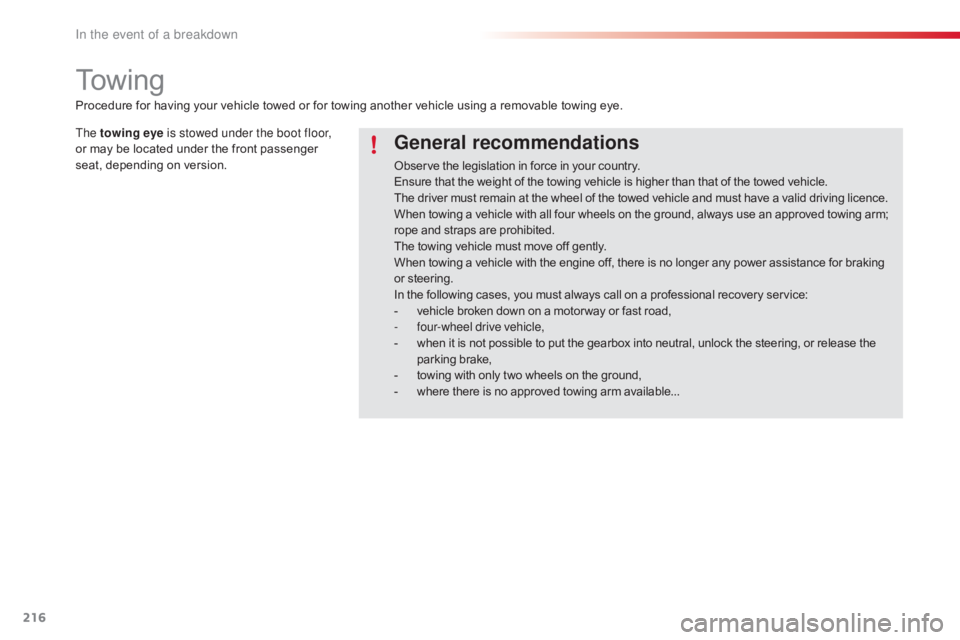
216
C4-cactus_en_Chap08_En-cas-de-panne_ed01-2016
To w i n g
General recommendations
Observeô theô legislationô inô forceô inô yourô country.
E nsure ô that ô the ô weight ô of ô the ô towing ô vehicle ô is ô higher ô than ô that ô of ô the ô towed ô vehicle.
The
ô driver ô must ô remain ô at ô the ô wheel ô of ô the ô towed ô vehicle ô and ô must ô have ô a ô valid ô driving ô licence.
When
ô towing ô a ô vehicle ô with ô all ô four ô wheels ô on ô the ô ground, ô always ô use ô an ô approved ô towing ô arm;
ô r
ope ô and ô straps ô are ô prohibited.
The
ô towing ô vehicle ô must ô move ô off ô gently.
When
ô towing ô a ô vehicle ô with ô the ô engine ô off, ô there ô is ô no ô longer ô any ô power ô assistance ô for ô braking
ô o
r ô steering.
In
ô the ô following ô cases, ô you ô must ô always ô call ô on ô a ô professional ô recovery ô service:
-
ô
v
ehicle ô broken ô down ô on ô a ô motor way ô or ô fast ô road,
-
f
our-wheel drive vehicle,
-
ô
w
hen ô it ô is ô not ô possible ô to ô put ô the ô gearbox ô into ô neutral, ô unlock ô the ô steering, ô or ô release ô the
ô par
king
ô b
rake,
-
ô
t
owing ô with ô only ô two ô wheels ô on ô the ô ground,
-
ô
w
here ô there ô is ô no ô approved ô towing ô arm ô available...
Procedure
ô
for
ô
having
ô
your
ô
vehicle
ô
towed
ô
or
ô
for
ô
towing
ô
another ô vehicle ô using ô a ô removable ô towing ô eye.
The towing eye is stowed under the boot floor,
or
ô
may
ô
be
ô
located
ô
under
ô
the
ô
front
ô
passenger
ô sea
t,ô d
ependingô o
nô v
ersion.
In the event of a breakdown
Page 222 of 317
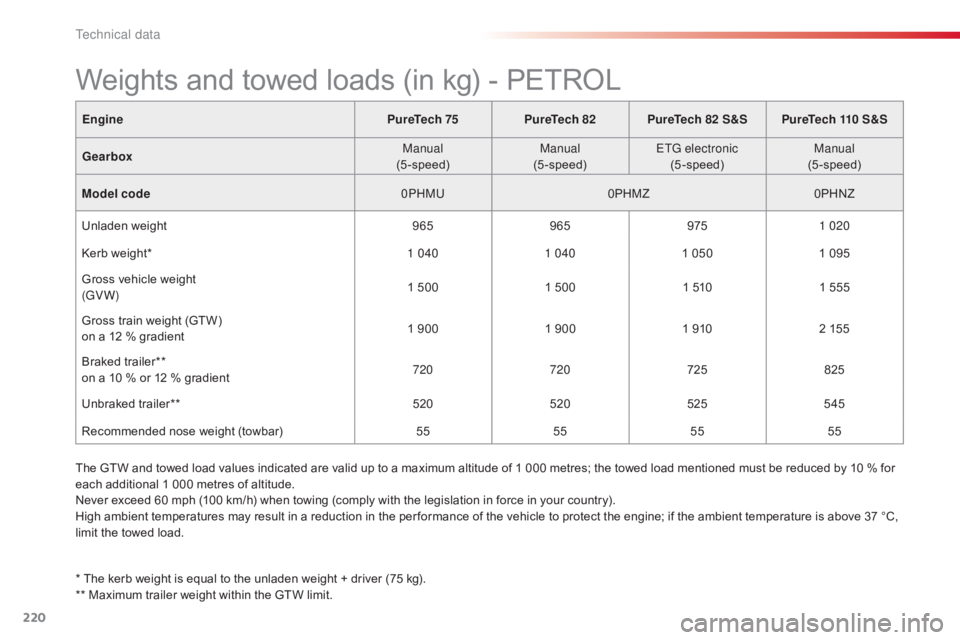
220
C4-cactus_en_Chap09_caracteristiques-techniques_ed01-2016
EnginePureTech 75PureTech 82 PureTech 82 S&SPureTech 110 S&S
Gearbox Manual
(5-speed) Manual
(5-speed) ETG electronic
(5-speed) Manual
(5-speed)
Model code 0PHMU0PHMZ0PHNZ
Unladen
ô weight 965965 9751 020
Kerb
ô weight* 1 0401 040 1
ô 0501
ô 095
Gross
ô vehicle ô weight ô
(GV W) 1
ô 5001
ô 5001
ô 5101
ô 555
Gross
ô train ô weight ô (GTW)
on
ô a ô 12 ô % ô gradient 1
ô 9001
ô 9001
ô 9102
ô 155
Braked
ô trailer** ô
o
n ô a ô 10 ô % ô or ô 12 ô % ô gradient 720
720 725825
Unbraked
ô t
railer** 520520 525545
Recommended
ô nose ô weight ô (towbar) 55555555
Weightsô andô towedô loadsô (inô kg)ô -ô PETROL
Theô GTWô andô towedô loadô valuesô indicatedô areô validô upô toô aô maximumô altitudeô ofô 1ô 000ô metres;ô theô towedô loadô mentionedô mustô beô reducedô byô 10ô %ô forô e
ach ô additional ô 1 ô 000 ô metres ô of ô altitude.
Never
ô exceed ô 60 ô mph ô (100 ô km/h) ô when ô towing ô (comply ô with ô the ô legislation ô in ô force ô in ô your ô country).
High
ô ambient ô temperatures ô may ô result ô in ô a ô reduction ô in ô the ô per formance ô of ô the ô vehicle ô to ô protect ô the ô engine; ô if ô the ô ambient ô temperature ô is ô above ô 37 ô ô¯C, ô
l
imit ô the ô towed ô load.
*
ô The ô kerb ô weight ô is ô equal ô to ô the ô unladen ô weight ô + ô driver ô (75 ô kg).
**
ô Maximum ô trailer ô weight ô within ô the ô GTW ô limit.
Technical data
Page 224 of 317
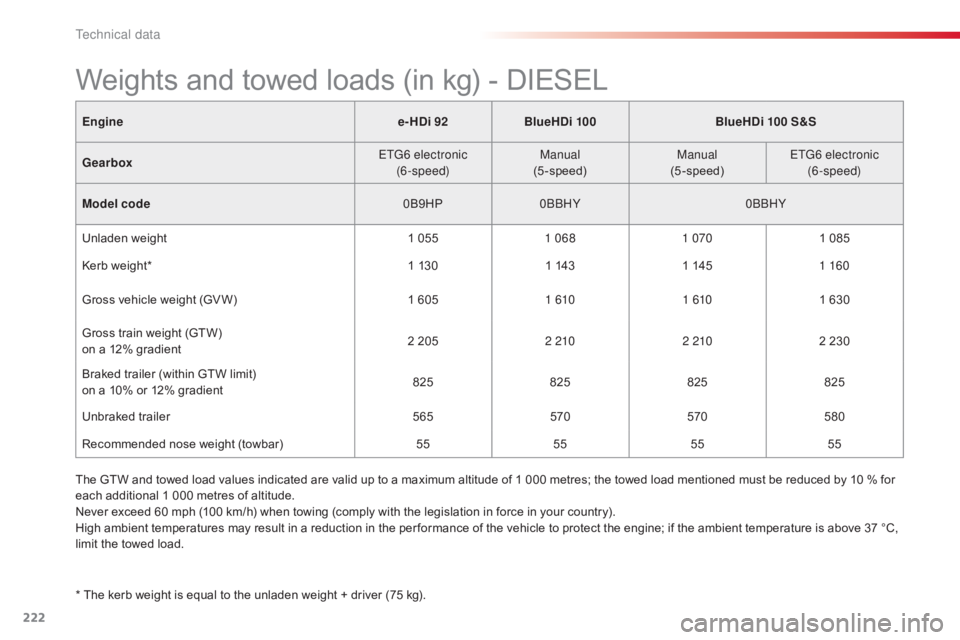
222
C4-cactus_en_Chap09_caracteristiques-techniques_ed01-2016
Enginee-HDi 92BlueHDi 100 BlueHDi 100 S&S
Gearbox ETG6 electronic
(6-speed) Manual
(5-speed) Manual
(5-speed) ETG6 electronic
(6-speed)
Model code 0B9HP0BBHY 0BBHY
Unladen
ô weight 1
ô 0551 068 1 0701
ô 085
Kerb
ô weight* 1
ô 1301
ô 1431
ô 1451 160
Gross
ô vehicle ô weight ô (GV W) 1
ô 6051 610 1 6101
ô 630
Gross
ô train ô weight ô (GTW) ô
o
n ô a ô 12% ô gradient 2
ô 2052 210 2 2102
ô 230
Braked
ô trailer ô (within ô GTW ô limit)
on
ô a ô 10% ô or ô 12% ô gradient 825
825825825
Unbraked
ô t
railer 565570570580
Recommended
ô nose ô weight ô (towbar) 55555555
Weightsô andô towedô loadsô (inô kg)ô -ô DIESEL
*ô Theô kerbô weightô isô equalô toô theô unladenô weightô +ô driverô (75ô kg).
T he ô GTW ô and ô towed ô load ô values ô indicated ô are ô valid ô up ô to ô a ô maximum ô altitude ô of ô 1 ô 000 ô metres; ô the ô towed ô load ô mentioned ô must ô be ô reduced ô by ô 10 ô % ô for ô
e
ach ô additional ô 1 ô 000 ô metres ô of ô altitude.
Never ô exceed ô 60 ô mph ô (100 ô km/h) ô when ô towing ô (comply ô with ô the ô legislation ô in ô force ô in ô your ô country).
High ô ambient ô temperatures ô may ô result ô in ô a ô reduction ô in ô the ô per formance ô of ô the ô vehicle ô to ô protect ô the ô engine; ô if ô the ô ambient ô temperature ô is ô above ô 37 ô ô¯C, ô
l
imit ô the ô towed ô load.
Technical data